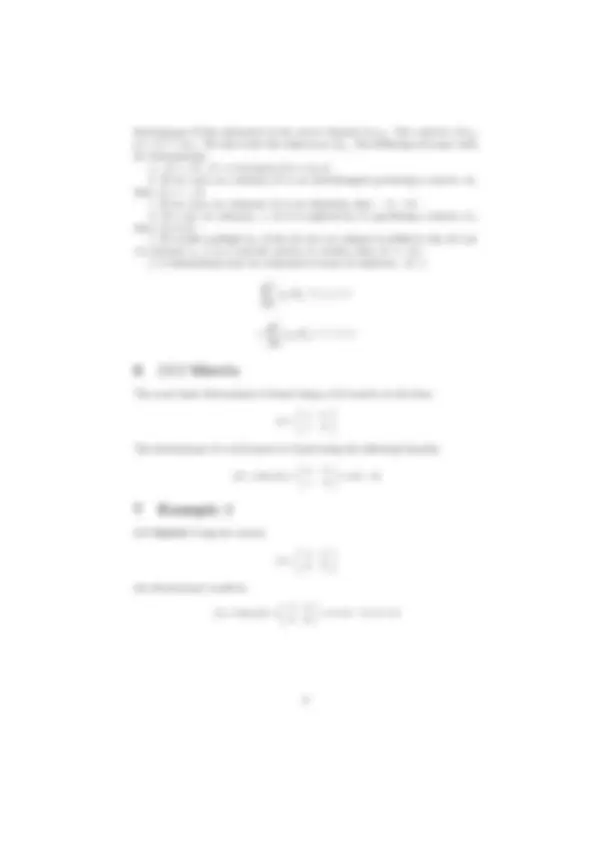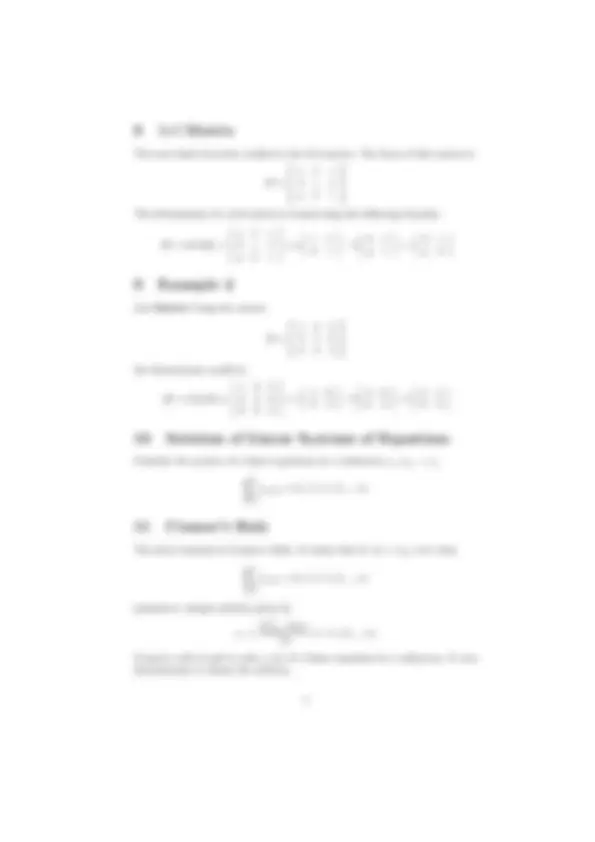





Study with the several resources on Docsity

Earn points by helping other students or get them with a premium plan


Prepare for your exams
Study with the several resources on Docsity

Earn points to download
Earn points by helping other students or get them with a premium plan
Community
Ask the community for help and clear up your study doubts
Discover the best universities in your country according to Docsity users
Free resources
Download our free guides on studying techniques, anxiety management strategies, and thesis advice from Docsity tutors
An in-depth exploration of determinants and their role in solving linear systems of equations. The paper covers the basics of determinants, their properties, rules, and the calculation of determinants for 2x2 and 3x3 matrices. Additionally, the document discusses the solution of linear systems of equations using cramer's rule and the alternative theorem.
Typology: Papers
1 / 5

This page cannot be seen from the preview
Don't miss anything!




1 Introduction 1
2 Determinants 1
3 An nxn Matrix 1
4 Properties of Determinants 2
5 Rules for Determinants 2
6 2 X 2 Matrix 2
7 Example 1 3
8 3 x 3 Matrix 3
9 Example 2 3
10 Solution of Linear Systems of Equations 3
11 Cramer’s Rule 4
12 The Alternative Theorem 4
In this paper, we will study determinants and solutions of linear systems of
equations in some detail. We will learn the basics for each and expand on them.
A determinant is a mathematical object which is very useful in the analysis and
solution of systems of linear equations. Determinants are only defined for square
matrices. A square matrix has horizontal and vertical dimensions that are the
same (i.e., an nxn matrix). The difference between the form of a matrix and a
determinant of a matrix is that a determinant is displayed using straight lines
in-place of the square brackets. The determinant is a scalar quantity, which
means a one-component quantity. The determinant is most often used to:
In an nxn matrix, we follow certain rules for the appearance of the matrix.
We let vi symbolize the i
th row. (ai 1 , ai 2 , ..., ain). If this row were to be mul-
tiplied by α, the the row would appear to be (αai 1 , αai 2 , ..., αain). Also, if
two rows were added, the i
th row and the j
th column, we would have (ai 1 +
aj 1 , ai 2 + aj 2 , ..., ain + ajn). A unit matrix appears with the following rows:
(1,0,0,...,0),(0,1,0,...,0),...,(0,0,0,...,1). Also, the letters e 1 , ..., en describe a unit
row.
In an nxn matrix there are a few forms in which a determinant is recognized.
First of all the determinant symbolizes the function of the n
2 variables aij (i, j =
1 , 2 , ..., n). The determinant for this function can be written as:
a 11 a 12... a 1 n
a 21 a 22... a 2 n
. . .
an 1 an 2... ann
= |aij | = D(v 1 , v 2 , ...vn)
Determinants are either written as |A| or detA. Now say that we delete the
i
th row and the j
th column a (n − 1)x(n − 1) submatrix Aij is formed. The
The next kind of matrix studied is the 3x3 matrix. The form of this matrix is
a b c
d e f
g h i
The determinant of a 3x3 matrix is found using the following formula:
|B| = det(B) =
a b c
d e f
g h i
= a
e f
h i
− b
d f
g i
d e
g h
3 x 3 Matrix Using the matrix
the determinant would be
|B| = det(B) =
Consider the system of n linear equations in n unknowns x 1 , x 2 , ..., xn
n ∑
j=
aij xj = bi (i = 1, 2 , ..., n)
The above formula is Cramer’s Rule. It states that if |A| = |aij | 6 = 0, then
n ∑
j=
aij xj = bi (i = 1, 2 , ..., n)
possesses a unique solution given by
xr =
∑n
i=
∗ ir bi
(r = 1, 2 , ..., n)
Cramer’s rule is used to solve a set of n linear equations in n unknowns. It uses
determinants to obtain the solution.
This formula that results from Cramer’s Rule is the Alternative Theorem. Also
described as the homogeneous system
n ∑
j=
aij xj = 0 (i = 1, 2 , ..., n)
possesses a non-trivial solution (i.e., a solution other than x 1 = x 2 = ... =
xn = 0) if and only if |A|=0. If for a fixed A = (aij ) there are solutions to the
non-homogeneous system
n ∑
j=
aij xj = bi (i = 1, 2 , ..., n)
for every selection of the quantities bi, then |A| 6 = 0 and the homogeneous system
had only the trivial solution.